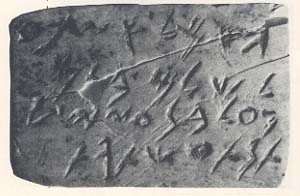Image Details

Courtesy James Pritchard, University Museum, University of Pennsylvania
Ivory plaque naming “Tanit Ashtart,” found in a small shrine in the industrial quarter of the seventh-century B.C. Phoenician city of Sarepta, eight miles south of Sidon on the Mediterranean coast. Professor James Pritchard of the University of Pennsylvania, who discovered this plaque, only 2 inches long and 1.3 inches wide, thinks that it might once have been attached to a statue. The four line Phoenician inscription reads: “The statue which SLM, son of MP‘L, son of ‘ZY made for Tanit ‘Ashtart.” (SLM may have been pronounced “Shillem,” and ‘ZY may have been pronounced “‘Uzzay.”)
This inscription provides the earliest clear evidence for the cult of Tanit in Phoenicia. With the discovery of this inscription, scholars now know that Tanit was originally a Near Eastern deity who ultimately received her greatest veneration in Carthage, where she was the leading goddess.
Other evidence of Tanit’s presence in the Levant is the “sign of Tanit” on a glass disk from Sarepta, on a stamped amphora from Akto, and on several terra cotta deity figurines found in the sea of Shaveh-Ziyyon, north of Akko.
